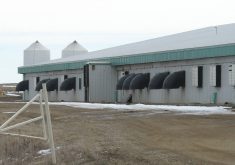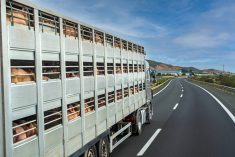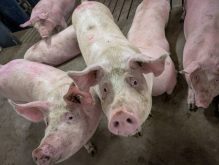Manitoba Pork’s new plan to combat porcine epidemic diarrhea, or PED, relies on disease surveillance, ‘wartime’ biosecurity, heavy crackdowns on infected farms and producer co-operation to eliminate the virus from the province.
“The long-term impacts of a major PED outbreak every other year is not sustainable,” the plan document says.
The pork council posted the PED roadmap to its website in early June and will spend the next month rolling it out to farmers and other stakeholders.
Read Also

Journal pulls long-cited glyphosate study for ethics violations
The journal Regulatory Toxicology and Pharmacology has retracted a 2000 Monsanto-linked glyphosate review, drawing new scrutiny as Bayer faces mounting legal pressure.
Why it matters: Manitoba is coming off its third major outbreak in six years. The Manitoba Pork Council would like to put that track record in the rear-view mirror.
PED can cause illness in pigs of all ages, but it’s usually fatal to newborn piglets under 10 days old. Dehydration, caused by watery diarrhea and vomiting characteristic of the virus, is the main threat. It kills 60 to 100 per cent of infected suckling pigs, according to materials published by the pork council. Piglets “waste away.”
Although feeders mostly recover, animals can become thin as they fight off the disease.
PED does not affect humans and it is not a food safety issue.

Since the virus reached Manitoba in 2014, it has caused serious financial loss to the sector. Major outbreaks blazed through the province in 2017, 2019 and 2021-22, with the largest recorded in the last two years.
Starting in fall 2021, 134 premises became infected or reinfected by the time the calendar switched to 2023. In mid-June last year, the province’s office of the chief veterinary officer estimated that 95,000 to 105,000 sows (based on barn capacity) had been impacted by the outbreak. Around a dozen cases were reported in 2022 after that estimate.
There has also been geographic spread. Southeastern Manitoba, where PED was first confirmed in 2014, remains a hot zone for the virus but cases have also been found in the northeast, central, southwest and the Interlake.
“Despite the sector’s commitment and best efforts, it was apparent that PED management and containment efforts needed to be reviewed,” the new plan reads.
Last year, the pork council announced a targeted effort to develop ways to break the cycle. A working group was formed, consulting with producers, veterinarians, academics and other stakeholders to develop a plan.
After studying strategies employed in other areas, the group decided elimination of the disease is the best option for Manitoba.

The vision
The framework’s goal is to eliminate 96 per cent of PED infections in the high-risk area (southeastern Manitoba) by 2027. Based on current outbreak case numbers, that would bring infections down to no more than 10 cases per year.
“We know we are going to continue to have risk,” said Jenelle Hamblin, director of swine health with Manitoba Pork.
Manitoba will continue to have contact with other regions where PED is prevalent, she noted. Also, the virus will continue to live in manure lagoons for some time.
However, the hope is that with strong containment procedures and few cases, any new outbreaks will be quickly stamped out.
The plan outlines four key outcomes: enhanced biosecurity across the sector; a 50 per cent reduction in cases year over year; reducing the time an infected farm needs to beat the virus; and decreasing the number of contaminated manure storages.
Biosecurity
PED outbreaks have already led producers to beef up normal biosecurity, Hamblin said.
“What was once considered enhanced biosecurity is actually now kind of commonplace in a lot of farms [in the high-risk area],” she said.
However, the council’s plan will encourage farms in the high-risk area to adopt “wartime” biosecurity — measures usually reserved for farms inside the buffer zone of an active PED infection.

Manitoba Pork will not prescribe exact biosecurity measures for farms. Each operation will be expected to develop plans with veterinarians to suit their situation.
The council knows heightened biosecurity will put more pressure and costs on farms, Hamblin said. It has added recommendations to the plan but knows farms will have to work out their own preferred systems.
For instance, she said, it’s better for biosecurity if one person does not visit three barn sites in one day. However, workers won’t appreciate working every weekend, and it may not be realistic to have three people check on three sites.
Surveillance
The council hopes all farms will adopt a surveillance program with regular testing for PED. That way, infections can be caught early and movement of infected pigs — a noted driver of PED spread — can be avoided, even if the infected animals have yet to show symptoms.
The PED framework includes two suggestions. Farms could test groups of pigs for PED on the week they’re scheduled for transport. Alternatively, producers could test barns weekly, regardless of scheduled movement.
The council based its ideas on surveillance plans already used on some farms that have proven effective, Hamblin said.
Manitoba Pork will continue to survey high-risk areas like abattoirs and assembly yards, added general manager Cam Dahl.
‘Rapid and aggressive’
Finally, the plan will rely on “rapid and aggressive” elimination of new infections.
This isn’t to say past responses haven’t been rapid or aggressive, Hamblin said. However, with increased surveillance, infections can be identified sooner, allowing for quicker response.
A baseline scenario in the framework shows an immediate lockdown of a farm with a suspected infection, with no movement of animals off the site for a minimum of four weeks.
An example sow barn in the plan aims to create a six-week gap in production through euthanasia or abortion of piglets, and disinfection after piglets are removed.
The framework also references “backfeeding” and vaccination of pigs to create herd immunity.
Backfeeding refers to exposure of pigs to the PED virus, such as through infected manure. This suggestion has not been popular with producers, Hamblin said.
“It’s super intensive and high risk,” she said. “It was not met with a lot of support.”
Vaccines are also problematic. A PED vaccine from Saskatchewan’s VIDO-InterVac arrived in Manitoba during a previous outbreak and saw widespread uptake, Hamblin said. However, it proved mostly useful for boosting immunity in pigs that had already been exposed to PED and didn’t do much for naïve animals. It was also expensive.
Another U.S.-based vaccine is available but producers must apply to the Canadian Food Inspection Agency to have it brought into Manitoba. Only a few farms have done so, Hamblin said.
VIDO-InterVac is looking to improve its vaccine’s effectiveness and make it more affordable, she added.
Voluntary measures
The framework rests entirely on producer co-operation. Farms won’t be forced to comply.
“If we get to the point that we have to use regulations to enforce [it], it’s not working,” Dahl said.
Many producers have already experienced the financial and mental health impacts of dealing with PED, Hamblin noted. Even being a PED-negative farm in a buffer zone can be stressful.


![“If we get to the point that we have to use regulations to enforce [it], it’s not working.” – Cam Dahl, Manitoba Pork Council.](https://static.manitobacooperator.ca/wp-content/uploads/2023/06/22103423/hogs_cropped_cmyk.jpeg)













